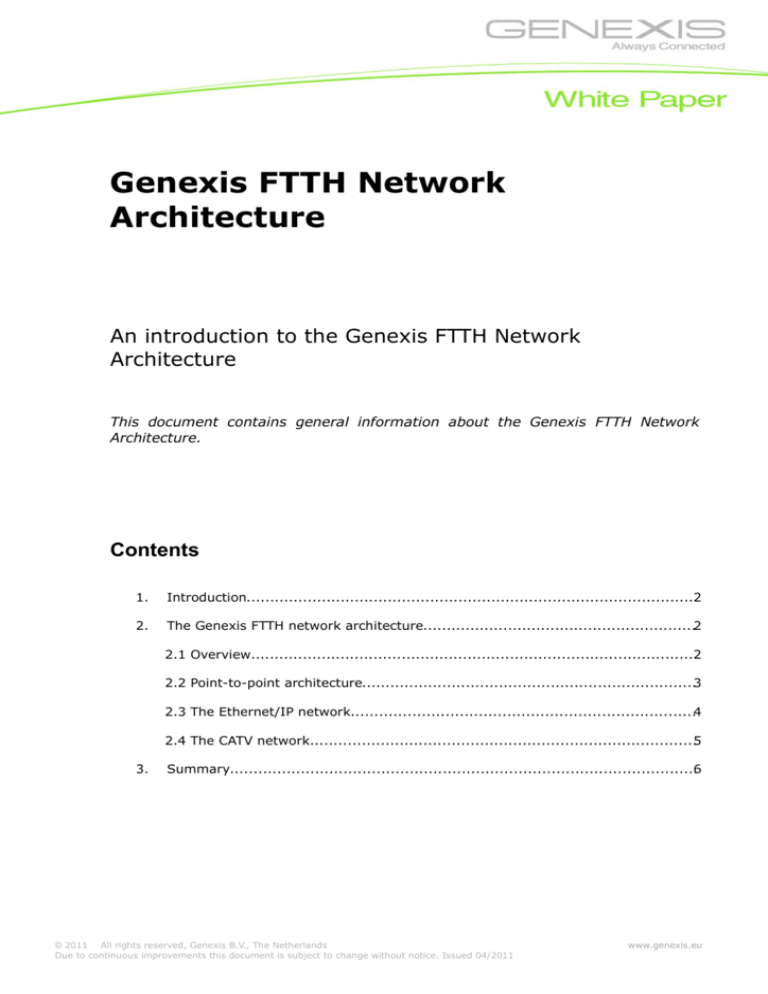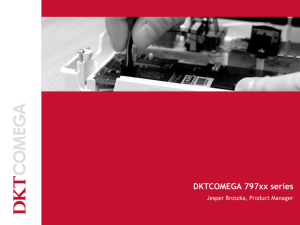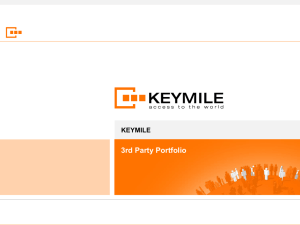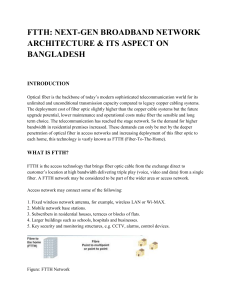
Genexis FTTH Network
Architecture
An introduction to the Genexis FTTH Network
Architecture
This document contains general information about the Genexis FTTH Network
Architecture.
Contents
1.
Introduction................................................................................................2
2.
The Genexis FTTH network architecture..........................................................2
2.1 Overview...............................................................................................2
2.2 Point-to-point architecture.......................................................................3
2.3 The Ethernet/IP network.........................................................................4
2.4 The CATV network..................................................................................5
3.
Summary...................................................................................................6
© 2011 All rights reserved, Genexis B.V., The Netherlands
Due to continuous improvements this document is subject to change without notice. Issued 04/2011
www.genexis.eu
1.
Introduction
This paper gives an overview of the Genexis fiber-to-the-home (FTTH) network architecture. Key in
the Genexis approach is the partitioning of the network in building blocks, which makes it easy to
engineer, build and maintain FTTH networks.
2.
The Genexis FTTH network architecture
2.1 Overview
Fiber-to-the-home networks are designed to deliver broadband services to end-users over fiber. The
network consists of a passive fiber infrastructure and active equipment to enable distribution of the
communication services. Figure 1 shows how the service providers and users are connected through
the FTTH network. The active network can be divided in a user part (customer premises equipment,
CPE) and a central office (CO) part. The CPE terminates the network at the user, providing a
conversion of the communication signals to services that the user can access. The CO functions as a
transport network to connect the users to service providers. The network is managed through the
network operations center.
Figure 1: Fiber-to-the-home triple-play network architecture. The central office and managed CPE parts
together form the active FTTH network.
Both the CPE and the CO parts have their own management tools and can be operated
independently from each other. In this way, each of these parts becomes a modular building block
within the FTTH network. Details of the network management system are described in the white
paper “Genexis Managed CPE platform”. In order to provide network guarantees, it is essential that
the interfaces between the building blocks or network elements are well-defined. With the right set
of standards and specifications, inter-working can be achieved.
The physical link between the CPE and central office parts of the network is based on a point-topoint architecture. Within this architecture, the FTTH network enables the transport of two basic
service types: communication through an Ethernet/IP network, and broadcast of (video) content
through a CATV network overlay. The following sections will discuss the point-to-point architecture
and describe the details of the Ethernet/IP network and the CATV network overlay.
© 2011
All rights reserved, Genexis B.V., The Netherlands
2
2.2 Point-to-point architecture
The Genexis FTTH network is based on a point-to-point (PtP) architecture. This is important for three
reasons:
1. Point-to-Point networks are future proof. In a PtP network each user is connected by a
dedicated fiber to the CO, offering ultimate flexibility. Users can be upgraded and connected
individually; the network is highly scalable and matches with future traffic patterns which are
based on peer-to-peer communications.1
2. The PtP architecture maps one-to-one onto Ethernet/IP packet switched networks.
Ethernet/IP is quickly becoming the default standard for interactive services; even optical
transport networks are moving from circuit switched (SONET/SDH) links towards Ethernet. A
fiber-to-the-home network should not only be compatible with Ethernet, it should be Ethernet
itself.
3. PtP offers the most cost efficient solution. Based on low-cost transceiver technology, a PtP
network provides more bandwidth to the user than shared medium networks while the actual
cost is lowest. Also, PtP networks are really scalable, also at low volumes: customers can be
added one at a time, and the central office equipment is utilised most efficiently.2 Lastly,
since PtP networks are the most widely deployed networks, the volume of networking
components and equipment is very high, implying commodity pricing.
In the Genexis FTTH network, each user is connected to a dedicated port on a central switch. At the
same time, each user is also connected to a CATV distribution system. Therefore, in the simplest
solution each user is connected to the central office with a single cable containing a fiber pair: one
fiber for bidirectional voice and data and one fiber for the CATV overlay. Solutions that multiplex all
signals (Ethernet/IP and CATV) on a single fiber can also be provided (see white paper “Single fiber
solution for point-to-point FTTH networks”).
Key is the logical separation of the transport of Ethernet/IP signals from the distribution of
(analog/DVB) CATV signals. Therefore in the following sections a distinction is made between the
Ethernet/IP network architecture and CATV network architecture. Both networks are terminated at
the customer in the Customer Premises Equipment (CPE).
1
2
Peer-to-peer communication forms more than 60% of all traffic today already. Only network architectures providing
symmetrical bandwidth services are ultimately compatible with this traffic pattern. Shared medium architectures like
passive optical networks (PON) provide only limited upstream capacity and will not be able to support next generation
communications.
In PON systems, connections are added in groups of e.g. 32, however the actual user distribution over a deployment
rarely matches this. This means that central office equipment will be under-utilized. This is especially important when a
FTTH network is expanded, and extra splitters and CO equipment have to be added just to provision a few customers.
© 2011
All rights reserved, Genexis B.V., The Netherlands
3
2.3 The Ethernet/IP network
Figure 2 provides an overview of the Ethernet/IP network. Within this network the router functions
as the central element, directing the transport of IP packets through the network. The access
switches transport the IP packets to the end-user. The Genexis managed Ethernet gateway, located
at the end-user, receives the IP traffic and translates it into application-related signals, like Internet
and (POTS) telephony.
The router performs several functions. Primarily it connects the various service providers to the
network: for example, internet-services via a firewall and telephony via a SIP-Proxy and PSTN
gateway. Furthermore the router functions as an access-point to the network for Network
Management applications, permitting to distribute network management signals across the network.
As the network is scaled to more users, the routing function is distributed over an array of
interconnected routers. Eventually, the routing function can be partitioned into two levels: a lower
level with distribution routers and a higher level with interconnection routers. The distribution
routers distribute the IP traffic to the various access switches, while the interconnection routers are
optimised to establish the interconnection to the service providers.
Figure 2: Overview of the Ethernet/IP network
The distribution of IP traffic via the Ethernet/IP network is based on standards:
Inter-working at layer 1: Physical layer
Optical interfaces at both sides of the passive infrastructure are compliant to the international IEEE
802.3ah standard:
•
The attenuation of the passive infrastructure should remain within a specified window
(minimum – maximum attenuation); in practice this means that the span loss of the link
between access switch and CPE needs to remain below the limit specified by the standard;
•
The optical transceivers in the CO and the CPE, performing the basic electric-to-optical
conversions, need to fulfil the requirements given by the IEEE 802.3ah specification; in
practice, this is guaranteed by the transceiver suppliers.
Inter-working at layer 2: Ethernet layer
At this layer, the transport of information between two points is defined.
© 2011
All rights reserved, Genexis B.V., The Netherlands
4
Both the CPE and CO-equipment need to comply with the Ethernet standard, IEEE 802.3. Full
network transparency is guaranteed by this standard.
In a FTTH environment, additional functions should be supported on top of Layer 2: setting VLANs
within CO and CPE, support of multi-casting (in both CPE and CO) and Quality-of-Service.
Inter-working at layer 3: IP layer
Within the IP-layer, the routing of IP packets through a network is defined. Items of relevance to this
layer are, for example, IP addressing, subnetting, and routing.
Above Layer 3 the application protocols, such as TCP/UDP, HTTP, SIP, are defined. The equipment
within the Central Office area is transparent to these service-related protocols. The central office
equipment is typically managed by using the Simple Network Management Protocol (SNMP).
Within the CPE, the traffic streams are handled on layer 2. In addition, the CPE does support a
number of critical layer 3 functions (for example VLAN tagging, QoS and multicasting). The voice
service, as well network management, terminates at the CPE. Voice is supported through the SIP
protocol (according to RFC 3261).
Figure 3 gives an overview of the various protocols, supported by the Genexis FTTH network.
Figure 3: Overview of the various protocols in the Genexis FTTH network.
2.4 The CATV network
Figure 4 provides an overview of the Genexis CATV network overlay.
Four basic elements are of relevance:
1. The optical transmitter translates the electrical (analog) signal of the head-end into an
optical signal suitable for distribution. This signal is transmitted within the 1550 nm
wavelength band in order to allow optical amplification of this signal;
2. The Erbium Doped Fiber Amplifier (EDFA) amplifies the optical signal to a level
appropriate for connecting the head-end to a large number of end-users. Depending on
the number of users and their physical location, one or more EDFAs can be used each
with its own gain and power.
3. The splitters arrange the actual distribution of the signal to the various end-users. These
are fully passive devices, not requiring any electrical power feeding or maintenance.
4. The Genexis optical CATV receiver, located at the end-user, translates the optical input
signal into an electrical signal, suitable for direct connection to conventional TV and Radio
equipment.
The Genexis network management system also offers control of the CATV network. Specifically, the
optical CATV receiver can be enabled and disabled remotely via the management system.
© 2011
All rights reserved, Genexis B.V., The Netherlands
5
Figure 4: Overview of the CATV distribution network
3.
Summary
The Genexis FTTH network provides a cost-efficient and mature way to enable real triple play on a
future-proof fiber infrastructure. Key points that distinguish this solution from alternatives are:
•
Highest bandwidth per user, prepared for next generation peer-to-peer communication.
•
Lowest cost in terms of OPEX and CAPEX.
•
FTTH network built from standard building blocks, enabling easy engineering, building and
maintenance.
•
Network management tools that support network operation and service provisioning in an
intuitive and automatic manner (see white paper “Genexis Managed CPE Platform”).
•
Focus on providing the best service to the end-user.
© 2011
All rights reserved, Genexis B.V., The Netherlands
6








